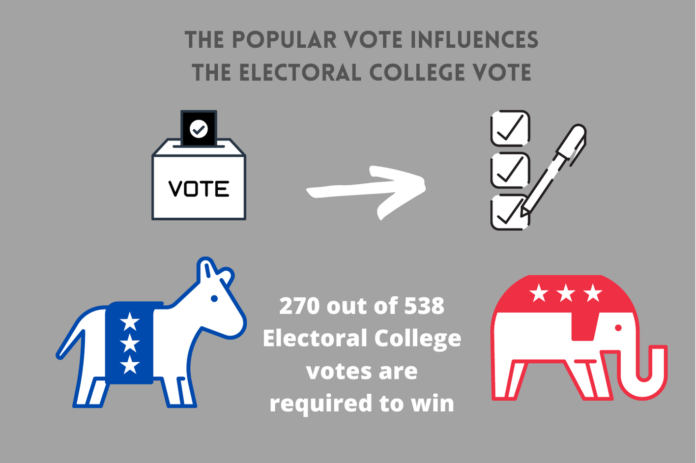
By Meredith Pratt | Staff Writer
The 2020 election will likely go down in history for taking place during the COVID-19 pandemic, but possible complications with the surge of mail-in ballots could lead to even more controversy.
Because of the influx of voters opting to mail in their ballots to avoid large gatherings at polling centers, many Americans wonder if states will be able to determine results by the end of election night on Nov. 3.
President Trump has made clear his skepticism about the integrity of mail-in ballots, saying there would be “fraud like you’ve never seen” in this election.
Constitutionally, Trump has no political control over when the final tallies must be submitted.
The Supreme Court, however, ruled Wednesday that even after Election Day battleground states Pennsylvania and North Carolina would be allowed to count absentee ballots for several days.
A graphic posted by the Associated Press shows each state’s deadline for returning absentee ballots. Washington’s deadline isn’t until Nov. 23.
Dr. Dave Bridge, professor of political science, said the speed at which these results are determined comes down to how individual states count their respective ballots.
“The constitution is pretty clear that each state has to tabulate the results,” Bridge said. “Different states have different procedures for doing that. Some of them are more streamlined. Some of them are not. So the long and short of it is some states are more efficient than others.”
Dr. Patrick Flavin agreed, saying vote tabulating is a “super state-driven process.”
“The president could certainly posture and make statements, but in terms of their constitutional powers, it is very limited,” Flavin said. “Which isn’t to say that you might not hear disputes after the election by the president, but in terms of institutional powers, there’s not much to go on.”
In order to better understand the upcoming election’s results, one must first be informed about the U.S. election process.
This process begins when candidates announce their intentions to run for president, typically during the spring of the year before an election. That same year, primary debates often take place.
As an incumbent, President Trump was expected to run again. His opponent, Democratic candidate Joe Biden, first announced his candidacy on April 25, 2019. Biden was one of 28 Democratic candidates.
Primary elections and caucuses take place from January to June of the election year in order to narrow down the candidates to the potential presidential nominee. Certain states try to hold these events early in the year to garner national attention. This is known as front-loading.
Iowa kicked things off in 2020 with a series of caucuses that took place on Feb. 3. New Hampshire led the first primary just eight days later. As more states held primaries and caucuses, candidates who did not receive a competitive amount of support began dropping out.
From July to early September, political party conventions are held to select the nominee that the party will unite behind. The votes from the primaries and caucuses translate to delegates who vote at the event.
This year, the Democratic convention took place Aug. 17-20 and the Republican convention took place Aug. 24.
At this point in the election process, campaigning kicks into high gear and the candidates travel across the country to share their vision with voters. In September and October, several debates normally take place between the presidential candidates and vice-presidential candidates.
Three debates took place this year, two between Trump and Biden on Sept. 29 and Oct. 22 and one between Vice President Mike Pence and vice-presidential candidate Kamala Harris on Oct. 7.
In some states, early voting begins in October, but Election Day always takes place in early November.
Once voting closes nationwide, the results from the popular vote are counted and the consequent electoral votes are allocated from each state. The electoral college is comprised of 538 electoral votes, therefore, 270 are needed to win the election.
When citizens cast their vote, they are actually voting toward an elector, not the actual candidate. These electors typically have to pledge that they will vote for whoever received the most votes in their state.
While most states allocate their electoral votes based on the winner-take-all method, Maine and Nebraska allocate the votes by district, meaning it is possible for their electoral votes to be split between candidates.
Although the results are usually predicted on election night, the actual electoral voters do not cast their votes in the electoral college until December.
In early January of the next calendar year, Congress counts the electoral votes and Inauguration Day will then take place on Jan. 20.
While constitutionally part of the election process, not every American is in favor of the electoral college.
Cleburne sophomore Caleb Barkman said he has “quite a few strong feelings about the electoral college.”
“There’s just tons and tons of weird scenarios that can happen because the electoral college has so many weird little quirks to it,” Barkman said. “If your main goal is to encourage democracy as much as possible, electoral college is not the way to do it. There are other ways to do it, like a direct popular vote.”
Despite these beliefs, Barkman said he doesn’t see the electoral college leaving anytime soon.
“I don’t think the electoral college will ever go away because changing the constitution is virtually impossible,” Barkman said.
Bridge noted that depending on what happens in the 2020 election, certain politicians might start to reconsider the electoral college.
“I actually think Texas is the key,” Bridge said. “If Texas turns blue or if Texas starts to get really, really, really purple, then you might start seeing the Republican Party think about getting rid of the electoral college, because if Texas turns blue, there’s no way that Republicans can win.”
For now, the American election process endures. It is lengthy, and the results may prove to be drawn-out as well.





